
Thousands of these specially tuned wires, each sniffing out a different chemical, can be layered onto tiny, wearable sensors, allowing health-care providers an unprecedented tool for monitoring potential health complications. Since these wires are grown by bacteria, they are organic, biodegradable and far greener than any inorganic nanowire.
To make these breakthroughs, which were detailed in the journal Biosensors and Bioelectrics, senior authors Derek Lovley, Distinguished Professor of Microbiology at UMass Amherst, and Jun Yao, professor of electrical and computer engineering in the College of Engineering at UMass Amherst, needed to look no farther than their own noses.
“Human noses have hundreds of receptors, each sensitive to one specific molecule,” says Yao. “They are vastly more sensitive and efficient than any mechanical or chemical device that could be engineered. We wondered how we could leverage the biological design itself rather than rely on a synthetic material.”
Working with nature
In other words, the team wondered if they could work with nature to sniff out disease—and it turns out they have done just that.
The answer begins with a bacterium known as Geobacter sulfurreducens, which Lovley and Yao previously used to create a biofilm capable of producing long-term, continuous electricity from sweat. G. sulfurreducens’ has the surprising natural ability to grow tiny, electrically conductive nanowires.
But G. sulfurreducens needs specific conditions in which to grow, making it difficult to use at scale. “What we’ve done is to take the ‘nanowire gene’—called pilin—out of G. sulfurreducens and splice it into the DNA of Escherichia coli, one of the most widespread bacteria in the world,” says Lovley.
Once the pilin gene was removed from G. sulfurreducens, Lovley, Yao and team modified it so that it would include a specific peptide, known as DLESFL, which is extremely sensitive to ammonia—a chemical often present in the breath of those with kidney disease. When they then spliced the modified pilin gene into E. coli’s DNA, the genetically tweaked bacterium sprouted tiny nanowires bristling with the ammonia-sensing peptide. The team then harvested these ammonia-sensitive nanowires and built them into a sensor.
“Genetically modifying the nanowires made them 100 times more responsive to ammonia than they were originally,” says Yassir Lekbach, the paper’s co-lead author and a postdoctoral researcher in microbiology at UMass Amherst. “The microbe-produced nanowires function much better as sensors than previously described sensors fabricated with traditional silicon or metal nanowires.”
New paradigm
And there’s no need to limit these new sensors to only to ammonia and kidney disease. Toshiyuki Ueki, the paper’s other co-lead author and research professor in microbiology at UMass Amherst, says: “It’s possible to design unique peptides, each of which specifically binds a molecule of interest. So, as more tracer molecules, emitted by the body and which are specific to particular a disease are identified, we can make sensors that incorporate hundreds of different chemical-sniffing nanowires to monitor all sorts of health conditions.”
Traditional nanowires, made from silicon or carbon fiber, can be highly toxic - carbon nanotubes are themselves carcinogens - and end up as non-biodegradable e-waste. Their raw materials can require enormous amounts of energy and chemical inputs to harvest and process, as well as leaving a deep environmental impact. But because Lovley and Yao’s nanowires are grown from common bacteria, they are far more sustainable.
“One of the most exciting things about this line of research is that we’re taking electrical engineering in a fundamentally new direction,” says Yao. ”Instead of wires made from scarce raw resources that won’t biodegrade, the beauty of these protein nanowires is that you can use life’s genetic design to build a stable, versatile, low impact and cost-effective platform.







No comments yet